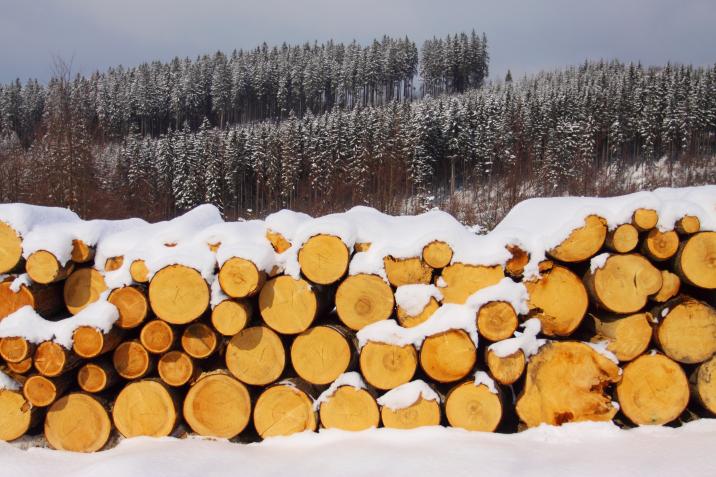 Asset Publisher
Asset Publisher
Surowiec do wszystkiego
W erze szkła, aluminium i krzemu można by odnieść wrażenie, że drewno jest passé. Nic bardziej mylnego! Gdziekolwiek się znajdziemy, na pewno wokół nas będzie wiele przedmiotów, które nie powstałyby bez użycia drewna.
Szacuje się, że współcześnie ma ono ok. 30 tys. zastosowań: drewno i materiały drewnopochodne są wykorzystywane m.in. w budownictwie, górnictwie, energetyce, do produkcji maszyn rolniczych i przemysłowych, podłóg, mebli, płyt, papieru i opakowań, narzędzi, instrumentów muzycznych, sprzętu sportowego, zabawek czy materiałów biurowych.
Szacuje się, że współcześnie drewno ma ok. 30 tys. zastosowań
Pochodzenie, sposób pozyskania i właściwości fizyczne drewna sprawiają, że jest najbardziej naturalnym i przyjaznym materiałem, który wykorzystujemy na tak wielką skalę. Jest niezbędnym elementem modnego dziś życia w stylu „eko", w harmonii z naturą i w zdrowiu. W obliczu zmian klimatycznych ważne jest też to, że nie tylko żywe drzewa wiążą znaczne ilości dwutlenku węgla. Wielkim magazynem CO2 są również produkty z drewna.
Im bardziej rozwinięta i nowoczesna gospodarka, tym więcej drewna potrzebuje. W ciągu ostatnich dwóch dekad zużycie drewna w naszym kraju wzrosło aż dwuipółkrotnie. W 1990 r. Polak przeciętnie zużywał rocznie równowartość 0,4 m sześc. drewna okrągłego, a obecnie – ponad 1 m sześc. Można się spodziewać, że ten wskaźnik jeszcze bardziej wzrośnie – do wartości podobnych jak w innych krajach europejskich (Niemiec zużywa rocznie średnio 1,7 m sześc. drewna, Czech – prawie 1,5 m sześc., Włoch– 1,1 m sześc.).
Dowiedz się więcej o drewnie z książki „Naturalnie, drewno!" (PDF)
 Asset Publisher
Asset Publisher
 Asset Publisher
Asset Publisher
FORESTS OF THE FOREST DISTRICT
FORESTS OF THE FOREST DISTRICT
Gubin Forest District manages over 21 thousand ha of forests. Nature wise the area is very interesting and rich in flora and fauna.
The area of the Gubin Forest District is characterised by diverse lay of the land, with many interesting features of landscape.
The Forest District is located at the western end of the Great Valleys zone (Pas Wielkich Dolin). The landscape was formed by névé of Oder and Pomerania, which has left morainic hills and sandurs, areas of common occurrence of washed sands. One can also see some inland sand dunes, peat bogs and swamps. The highest prominence is found in the southern part of the forest district – 106.4 m above sea level, whereas the lowest point is the surface of Borek lake - 33.2 m above sea level.
The territorial scope of the Gubin Forest District is 38 633 ha. The forestation rate is high - 54,7%.
The area of the largest forest complex is 15,000 ha (including the adjacent forests of the Brzózka Forest District). The second largest forest complex lies on the Strzegom Plain (Równina Strzegomska) with the area of around 7,000 ha.
Forests of the Forest District grow mainly on sandy lands, less often on clayish or swampy lands.
The dominant tree species is pine, which grows on 92% of forest area. Oak grows on over 3% of the area. Habitat of birch exceeds 2% of the area; other species - 3%.
Plant cover of forest ecosystem includes also shrubs and underbrush plants. One can also find large areas of forest overgrown with bilberry, cowberry and picturesque moorlands. More abundant plant associations are found near the areas of water, ecological sites, forest wastelands, next to meadows, as well as on the remains of peat bogs and forest swamps. There are numerous clusters of alder buckthorn (Jasienica), sites of dwarf periwinkle and round-leaved sundew (sub-districts Gubin and Chlebowo), lily of the valley (the vicinity of Budoradz and Dzikowo) and clubmoss (near Kaniów).
The fauna of the Forest District is represented by many game species:
● mammals: wild boar, red deer, roe deer, fox, European hare, European rabbit, muskrat, European pine marten, beech marten, polecat, badger, raccoon dog, American mink, beaver,
● birds: many species of ducks and goose, grey heron, coot, common wood pigeon, snipes,
● protected animals: weasel, otter, gołąb, turtledove, Eurasian collared dove, stock dove,
● insects: dragonfly.









 Lasy nadleśnictwa, fot. Jerzy Malicki
Lasy nadleśnictwa, fot. Jerzy Malicki
 fot. Mariusz Grondys
fot. Mariusz Grondys



